
To accrete a surface
by Jahnne Pasco-White
- View Jahnne Pasco-White's Biography
Jahnne Pasco-White is an artist based in Melbourne.
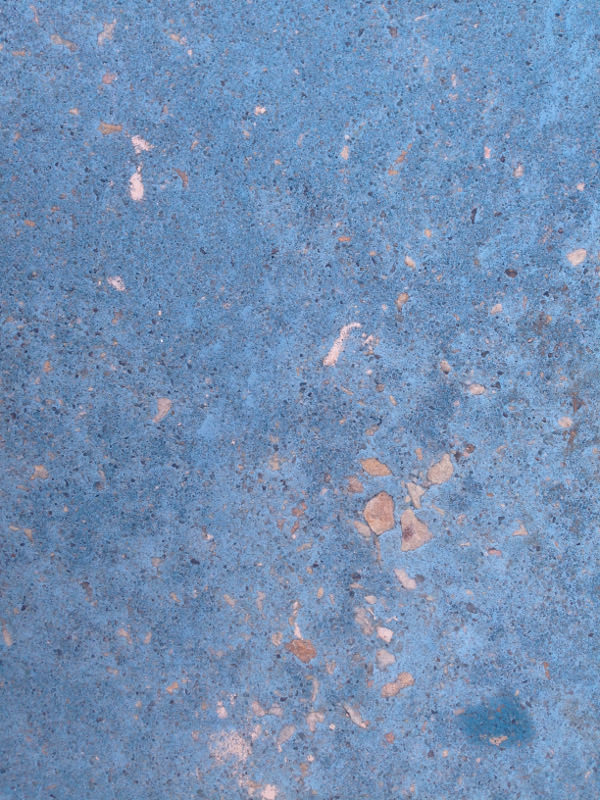
the oceanic mass, waves of feeling. A wall of blue. A wave of blue, by Jahnne Pasco-White, 2017.
To accrete a surface
Jahnne Pasco-White
I.Walls
Somebody was in the process of applying a layer of paint on a large billboard. The transition from a previously tarnished surface to the freshly-painted plane mesmerised me. It was a chance encounter with the moment of its erasure.
As if I was watching a dance, I fell into the marks and movements of the roller; the rounded forms shifted between figure and ground as they came into contact with the surface, the swooping gestures swirled and entangled into each other, each stroke varied in density of paint, the marks of the paint charted the limitations of the body's reach. The negative and positive spaces were constantly shifting modes. These two states of erasure and addition were simultaneously entangled and repelled by each other.
This essay started as an attempt to reflect on my work
Motion in the opposite direction as part of the exhibition Braided Field that was held in abandoned block in Melbourne, Australia.1
These reflections aim to consider my actions of covering an existing wall with a new layer. Like the billboard in Oaxaca, the painting on the Coburg wall neutralises the plane. Through this act of cancellation, I am able to reconsider how this new state has erased its previous capabilities. Through the reframing of these planes the surface can go on to support and facilitate various stages of regeneration and renewal. There is the reincarnation of an existing structure that arises through the tension created by the addition of a new element. I am interested in the potential of these intersections, of an existing form to take on a reconfiguration of its original purpose and provide a new direction forward.
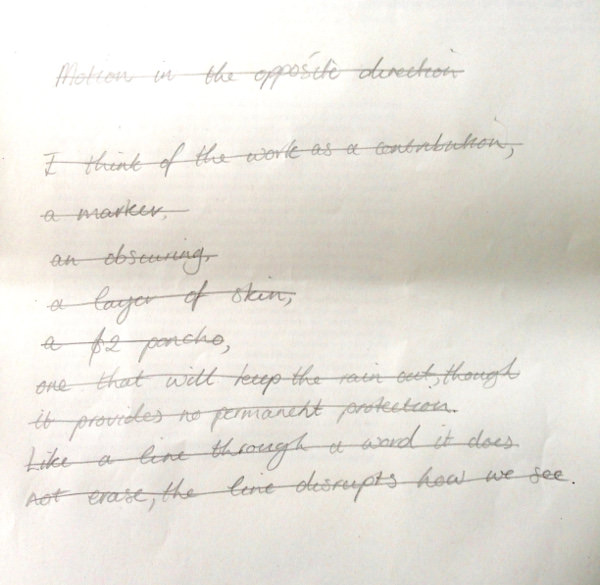
Notes in response to Motion in the Opposite Direction, Jahnne Pasco-White, 2017.
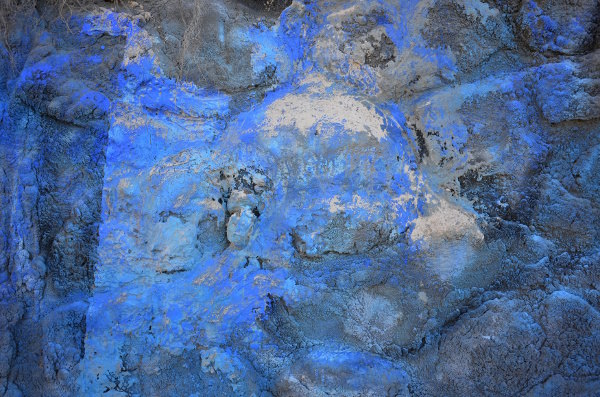
Detail of Motion in the opposite direction by Jahnne Pasco-White 2017.
The wall itself sits in an industrial context and holds a vast area of the block which is a combination of existing bluestone with large areas patched with grout that has eroded over time from the rain. This has created a strange coral sponge like texture in certain areas. The surface is made up of parts, which include previous graphing and tags on the wall. Other areas have plants growing, creepers, weeds, grasses, spurting from the wall. A section of the wall, 4x3 metres large, is orange brick. This surface is smoother and more even.
Motion in the Opposite Direction, a large-scale painting, was developed onto this wall in situ on a derelict block by the Merri Creek in Coburg, Melbourne. Made with wild fennel, grasses, thistles, sugar spray paint, raw blue pigments, turmeric, rainwater, plaster, grout, rubbish found on the block, the 11 x 7 metre work was made onto a large retaining wall. I covered the bluestone wall in a layer of blue pigment creating a new plane redefining the bluestones previous state. Through this erasure a process of regeneration in the form of a painting is born.
The painting will erode over time due to its exposure to the changing weather. The rain and sun will cause the pigment to fade. Despite the retaining walls role---to resist the lateral pressure of the soil---the wall is porous and crumbling. The instability of the wall's surface contributes to the continuing changing form of the painting, and how the painting exists. The irregular state of the bluestone and concrete wall allows the potential for the medium of painting to take form beyond the flat. In this intersection covering the wall that has introduced a new plane, a layer of translucent blue over the wall that can provide a shift in its previously exhausted state: the introduction of a new element provides a point of tension that shifts this work into an exuberant state. This sudden change in its mode to one of "exuberance", allows the object/wall to be redefined due to its position in a new set of circumstances and becomes a generative force beyond itself.2
In this relocation, these switching positions, exhaustion and exuberance, are able to generate new ways of seeing both the materials and the architecture it now resides in.
The unknown collaborator who authored the single line characters assume the background, establishing form and wandering shape against the textured surface of the wall. Over the months to follow these figures progress to the foreground as the layer of blue pigment attrite with the rain. Peeling back, adding another layer whist simultaneously erasing the previous.
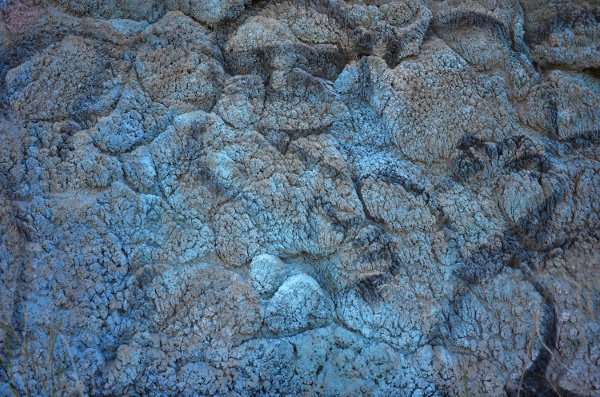
Detail of Motion in the opposite direction, by Jahnne Pasco-White, 2017.
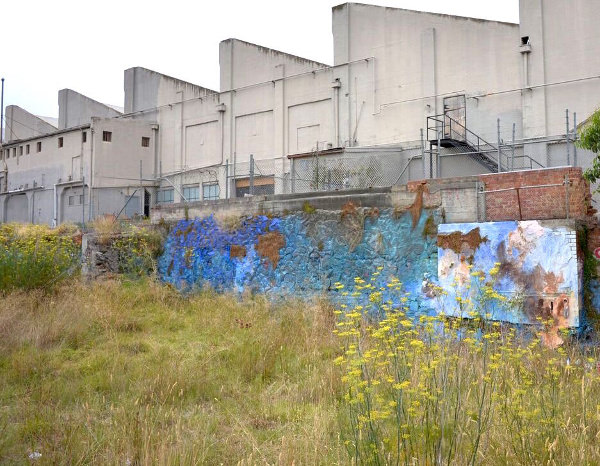
Motion in the opposite direction, image by Jahnne Pasco-White, January 2017.
My practice is centred around process. The outcome is often put to chance inspired by Merce Cunningham's technique of finding a way between norm and improvisation, between repetition and invention.3 It is in these transformative stages where the unimagined can come into fruition. By making use of chance procedures, a generative space is produced. These intersections of erasure to the conventional language (whether it be dance or painting) that was once used and known is challenged by its very removal. The abandonment of the conventional elements of dance composition (and painting) undo the system. The dance is free to act as it chooses. There is an importance to making through an intuitive and responsive set of parameters that follows a model of nomadic movement that progresses in unpredictable, and unstructured directions. The use of material and environment does not operate in a linear fashion, but instead opens to more expansive possibilities, of forging new collaborations of old and new material throughout the process of getting to know the qualities of the medium, to understand technique so one can abandon it.
II. The block as an undefined messy space
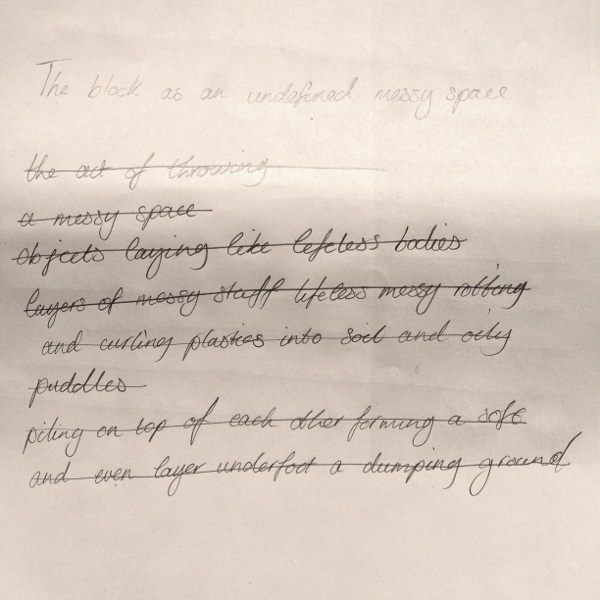
Notes in response to Motion in the Opposite Direction, Jahnne Pasco-White, 2017
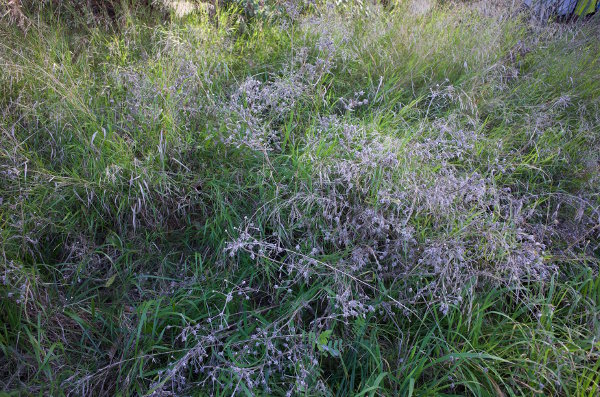
Image by Jahnne Pasco-White, 2017.
The abandoned block sits in an industrial area alongside the Merri Creek in East Brunswick. Measuring at 4388 sqm the entire block is fenced in with tall wire fences with two strands of barbed wire on the top. There is a section of the left side of the property, upon street entry, where there runs a two-metre tall wooden fence in place of the wire fence. The right perimeter of the property is reinforced by a brick retaining wall with barbed wire fencing on top of it. There are discarded plastic water bottles, polystyrene foam pieces, faded chocolate bar wrappers, coffee cups. There are plastic bags strewn through blossoming yellow fennel that measures to over three metres high.
The vacant plot feels like a time capsule, passing by it almost disappears out of existence, it has been ignored for many years. The "native" grasses and "wild" fennel have claimed the space. The years of accumulated rubbish has reinvented itself into a marmallowy ground which has layered like skin covering dumped rubbish into soft grassy mounds. Yet inside, after spending time there, there are markers of change and points that time continues. Wrappers fade. Graffiti on the walls change, winding paths stamping down the grass become visible.
This space operates under its own ecosystem, one of of graffiti artists, opportunists, such as ourselves, and others. Yet what is appealing about the block, is that people have chosen to occupy the space and use it, rather than claiming it as their own and become territorial, it seems engagement with the space is carried by an interest in what happens afterwards. The occurrences of before and after that inform and invigorate the works produced in the space, where past and present histories sit side by side. There are tensions between processes of attrition occurring within the space, to that of the quiet additions, to that of intersections, of cancellation.
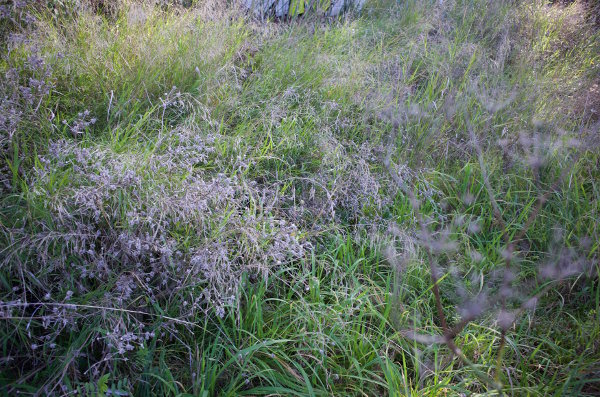
Image by Jahnne Pasco-White, 2017.
After cancelling
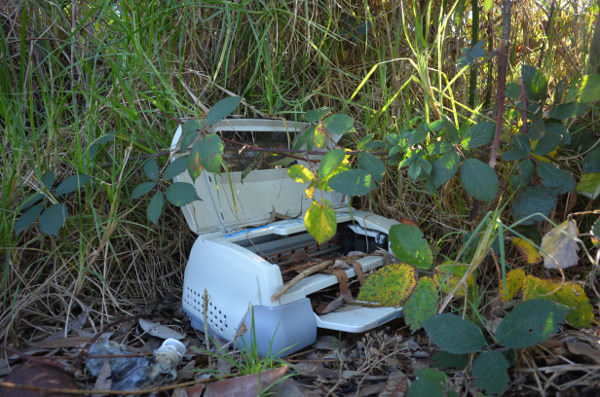
Image by Jahnne Pasco-White, 2017.
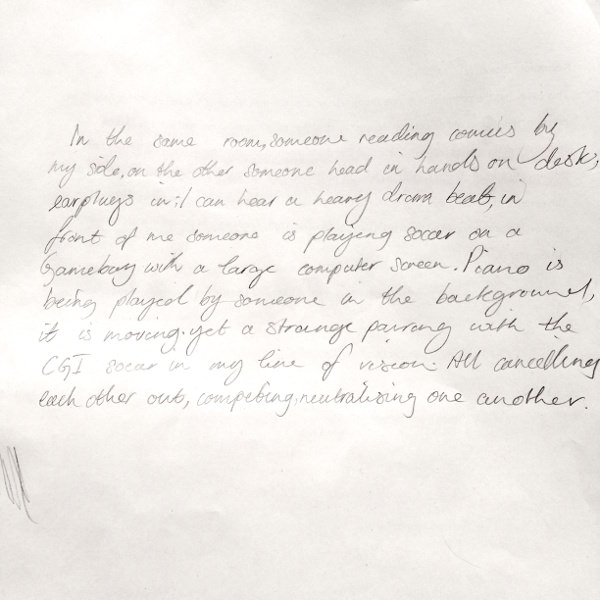
Notes in response to Motion in the Opposite Direction, Jahnne Pasco-White, 2017
'Measuring the rhythm of the membranous wall as the fingers percuss for the volumes behind it. Working out tensions in the wall's skin and why is it cracked the way it is; sounding out the wall through vibrating it, bringing about distortions of its sound and tensing the flesh which palpates it.' 4
I consider the painting as an incarnation that can, due to its environment and circumstance, have the potential to take on its own lifeform beyond my authorship into a life that has many iterations. The marks from the painting can contribute to an evolution of changes that this wall may encounter; a process that evolves, degrades, erodes, and renews. Like skin repairing with new layers, the marks and the lines stay the same; the indentations.
In my making, there is a lot of touch involved. A process that involves feeling out materials through the textures and shape they take on in different conditions. Composing collections of tactile arrangements onto a wall to layer and add and build and cover so I can then scratch and peel and erode. A process of adding and subtracting occurs on the same plane, toying with each other until they can become, in some way, fused with one another. Entirely dependent on being overworked to then fall apart. The layered surface undoes itself through exhaustion, though being so attended to, through such vigour of addition it collapses within itself.
Through the use of an existing material, my process often encompasses a reconfiguration of a materials original purpose. From painting on a curtain, cutting up a bedsheet to using dental casting plaster to create textures in paint, these intersections cancel and reorientate the materials prescribed value/use to expansive possibilities in how one can look at a curtain. By beginning with a process of cancellation that leads to a variety of directions forward. There is moment of possibility and simultaneous slippage that provides tension that I aim to explore in my practice. By considering my surroundings to be a key role in the process of making and therefore makes the most from what I can find and make from my environment. The process of pulling together an arrangement to let the work then shape itself. Past and present moments are brought together creating a disparity between tenses, leaving space between each encounter creating a non-linear work.
It is this temporality and continued cancellation through processes of both addition and subtraction that keeps the work in a constant state of flux. The newly introduced brown tag (added around three months after the work was finished by an unknown author) contributes to an ever-evolving work that takes its own form. New collaborators simultaneously mask and erase sections, perhaps it is an ongoing process of participation, where the collaborators are unknown to each other.
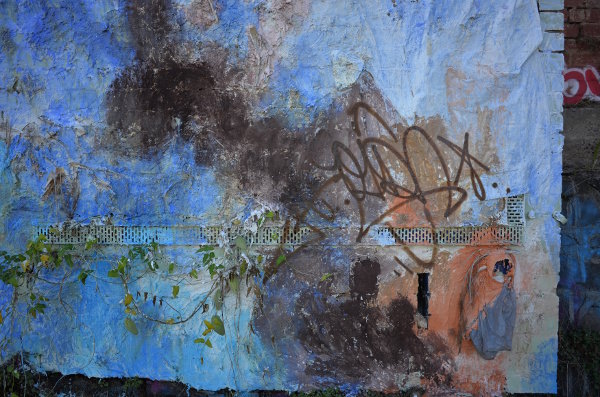
Detail of Motion in the opposite direction, Image by Jahnne Pasco-White, May, 2017.
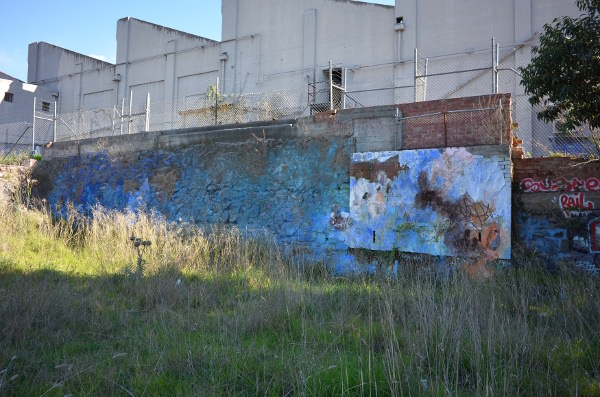
Motion in the opposite direction, Image by Jahnne Pasco-White, June, 2017.
A multitude of possible pathways for the furthering and development of a work can be found in the use of pre-existing materials and sites. Like the man painting the billboard, I look to existing surfaces that I can intercept. By working into and against with my own mark making and painterly gestures, to craft a more comprehensive or complex surface that proceed towards a re- direction of material. This re-direction of the discarded material sets out a parameter to both operate within and brush up against. By mapping my movements encourage an ongoing negotiation through a process of piecing together multiple facets in an aim to amalgamate material and their surroundings. It is part of my practice to maintain a movement that can continually reignite this approach of the minor position towards painting; to approach painting from multiple perspectives.
This idea of re-creation is akin to a process of composting, for it is not in dismissal or an erasure of past lives that the material becomes lively, it is with the acknowledgment and re-saturation of these elements that a kind of breakdown and renewal or re-direction can take place. It is in these fertile conditions that material processes can be reinvented and expand to something else. Without these conditions, the compost becomes stagnant and materials rot, they become exhausted and breakdown with an unproductive potency. Vitality occurs in the shifting between the multiplicity of layers that is informed by engaging with various states, tensions, filters, gestalts, realities and perspectives. At times for that vitality to occur the materials original prescription needs to be abandoned and cancelled.
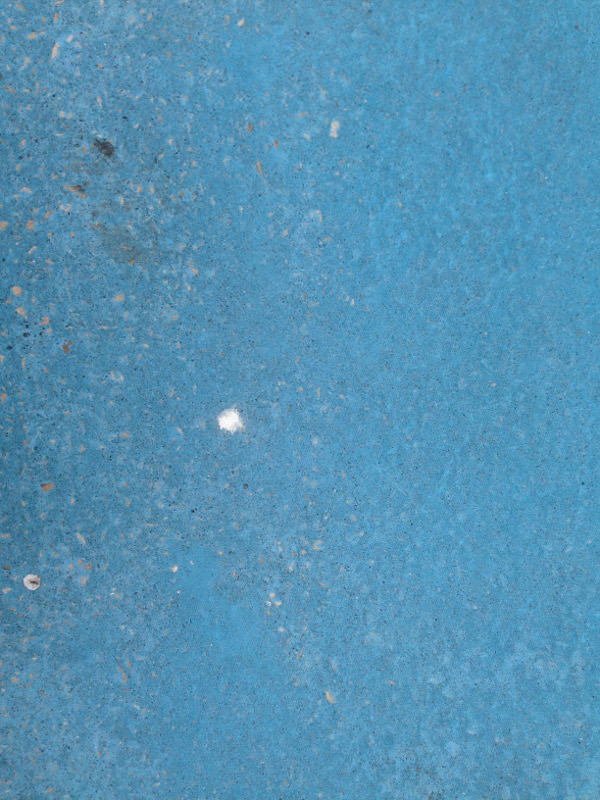
I would like to live in a padded world of weightless blue hues, image by Jahnne Pasco-White, 2017.
Footnotes
- Motion in the Opposite Direction is a large-scale wall work that I made in situ as part of a group exhibition Braided Field, an offsite project developed by Brunswick Sculpture Centre, an independent project and studios based in Brunswick, Melbourne. The exhibition included works by Aaron Carter, Alice McIntosh, Isadora Vaughan, Nell Pearson and a performance by the Shinkies (Grace Anderson, Josey Kidd-Crow, Hana Earles, Edith Fuck). ↩
- Verwoert, Jan. "Exhaustion and Exuberance: Ways to defy the Pressure to Perform." Dot Dot Dot Magazine. December 15, 2007. ↩
- Preciado, Paul B. Testo Junkie: Sex, Drugs, and the Biopolitics in the Pharmacopornographic Era. (The Feminist Press, City University of New York.) 373. ↩
- Lahey Dronsfield, Jonathan. "A strange image you speak of he said", Allegory of the Cave Painting, (Mousse Publishing, 2015) 126. ↩

